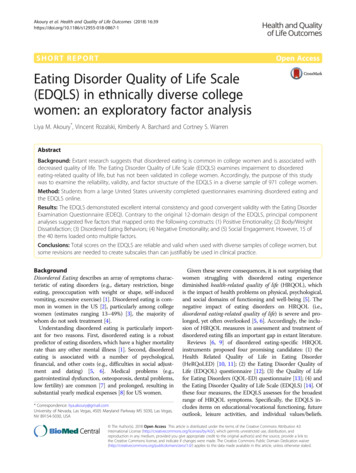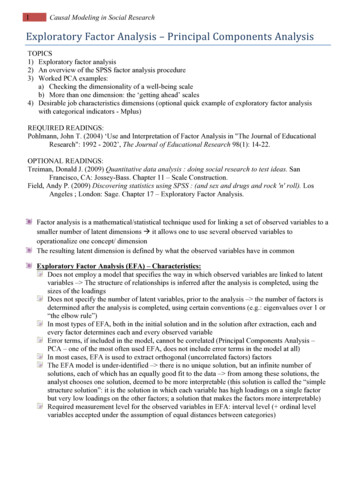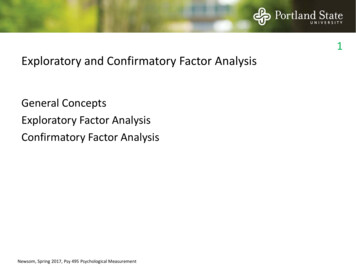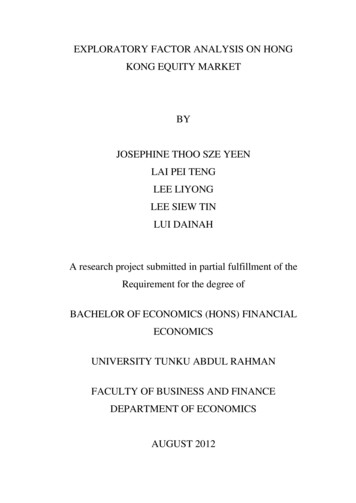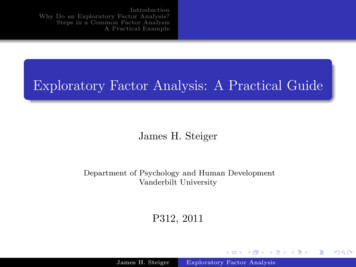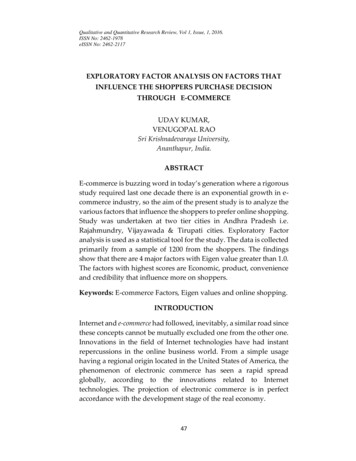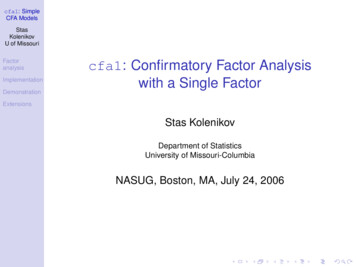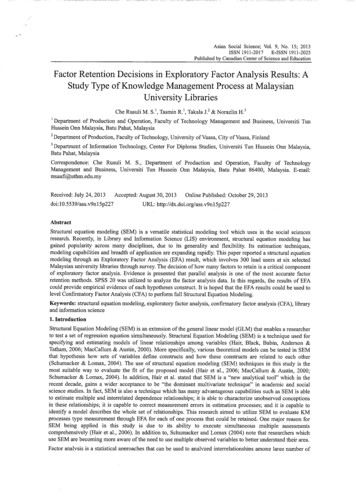
Transcription
Asian Social Science; Vol. 9, No. 15; 2013ISSN 1911-2017 E-ISSN 1911-2025Published by Canadian Center of Science and EducationFactor Retention Decisions in Exploratory Factor Analysis Results: AStudy Type of Knowledge Management Process at MalaysianUniversity LibrariesChe Rusuli M. s.', Tasmin R.', Takala J . & Norazlin H . 1Department of Production and Operation, Faculty of Technology Management and Business, Universiti TunHussein Onn Malaysia, Batu Pahat, MalaysiaDepartment of Production, Faculty of Technology, University of Vaasa, City of Vaasa, Finland3Department of Information Technology, Center For Diploma Studies, Universiti Tun Hussein Onn Malaysia,Batu Pahat, MalaysiaCorrespondence: Che Rusuli M. S., Department of Production and Operation, Faculty of TechnologyManagement and Business, Universiti Tun Hussein Onn Malaysia, Batu Pahat 86400, Malaysia. E-mail:msaufi@uthm.edu.myReceived: July 24,2013doi:10.5539/ass.v9nl5p227Accepted: August 30,2013Online Published: October 29,2013URL: http://dx.doi.org/ass.v9n15p227AbstractStructural equation modeling (SEM) is a versatile statistical modeling tool which uses in the social sciencesresearch. Recently, in Library and Information Science (LIS) environment, structural equation modeling hasgained popularity across many disciplines, due to its generality and flexibility. Its estimation techniques,modeling capabilities and breadth of application are expanding rapidly. This paper reported a structural equationmodeling through an Exploratory Factor Analysis (EFA) result, which involves 300 lead users at six selectedMalaysian university libraries through survey. The decision of how many factors to retain is a critical componentof exploratory factor analysis. Evidence is presented that parallel analysis is one of the most accurate factorretention methods. SPSS 20 was utilized to analyze the factor analysis data. In this regards, the results of EFAcould provide empirical evidence of each hypotheses construct. It is hoped that the EFA results could be used tolevel Confirmatory Factor Analysis (CFA) to perform full Structural Equation Modeling.Keywords: structural equation modeling, exploratory factor analysis, confirmatory factor analysis (CFA), libraryand information science1. IntroductionStructural Equation Modeling (SEM) is an extension of the general linear model (GLM) that enables a researcherto test a set of regression equation simultaneously. Structural Equation Modeling (SEM) is a technique used forspecifying and estimating models of linear relationships among variables (Hair, Black, Babin, Anderson &Tatham, 2006; MacCallum & Austin, 2000). More specifically, various theoretical models can be tested in SEMthat hypothesis how sets of variables define constructs and how these constructs are related to each other(Schumacker & Lomax, 2004). The use of structural equation modeling (SEM) techniques in this study is themost suitable way to evaluate the fit of the proposed model (Hair et al., 2006; MacCallum & Austin, 2000;Schurnacker & Lomax, 2004). In addition, Hair et al. stated that SEM is a "new analytical tool" which in therecent decade, gains a wider acceptance to be "the dominant multivariate technique" in academic and socialscience studies. In fact, SEM is also a technique which has many advantageous capabilities such as SEM is ableto estimate multiple and interrelated dependence relationships; it is able to characterize unobserved conceptionsin these relationships; it is capable to correct measurement errors in estimation processes; and it is capable toidentify a model describes the whole set of relationships. This research aimed to utilize SEM to evaluate KMprocesses type measurement through EFA for each of one process that could be retained. One major reason forSEM being applied in this study is due to its ability to execute simultaneous multiple assessmentscomprehensively (Hair et al., 2006). In addition to, Schumacker and Lomax (2004) note that researchers whichuse SEM are becoming more aware of the need to use multiple observed variables to better understand their area.e s can be used to analvzed interrelationshi samong large number ofFactor analvsis is a statistical a r o a c hthat
www.ccsenet.orglassAsian Social ScienceVol. 9, No. 15; 2013Table 20. Total variance explained for variables of the library users' satisfaction factorComponentInitial EigenvaluesTotal% of VarianceExtraction Sums of Squared LoadingsCumulative 665.45 17.51393.1796.4096.821Extraction Method: Principal Component Analysis.% of VarianceTotal3.06251.036Cumulative %51.036100.000All variables of knowledge preserving factor have loading value higher than 0.50 as shown in Table 21.Therefore, these values indicate that they are highly interrelated with each other.Table 2 1. Component matrix of the library users' satisfaction variablesComponent1LUS 1LUS2LUS3LUSS.775LUS6Extraction Method: Principal Component Analysis.5814. DiscussionAfier presenting the analyses, three important results have been shown. Firstly, Kaiser-Meyer-Olkin (KMO)measures of sampling adequacy for knowledge creation, knowledge acquisition, knowledge capture, knowledgesharing, knowledge record, knowledge preserving and library users' satisfaction factors) are within the requiredrange. Therefore, the KMO value of 0.70 and above indicates strong partial correlation and is suitable for factoranalysis (Hair et al., 2006). The KMO values are 0.735, 0.767, 0.769, 0.826, 0.869, 0.799, and 0.821 forknowledge creation, knowledge acquisition, knowledge capture, knowledge sharing, knowledge record,knowledge preserving and library users' satisfaction factors respectively. The highest KMO value is 0.869(knowledge record factor). The lowest KMO value is 0.735 (knowledge creation factor). Thus, all factors will beincluded in the further analysis. All Bartlett's tests of Sphericity have shown good results. All small values whichless than 0.05 indicate that there are significant relationships among variables (Hair et al., 2006; Tabachnick &Fidell, 2007). Lastly, EFA for all factors (knowledge creation, knowledge acquisition, knowledge capture,knowledge sharing, knowledge record, knowledge preserving, and library users' satisfaction factors) attain goodloadings to become a factor retention. The value of loadings for all indicators are above 0.50 (good level), exceptfor one indicator. There is indicator of KSh5 (0.405) from the knowledge sharing process factor. This indicatorwas excluded from the subsequent SEM analysis due to overlaps factor loading (less than 0.5). The low factorloadings indicate that the explained variance is much less in the measure than the error variance. In theseinstances, the researcher or analyst requires that exploratory factor analysis take into confirmatory approach, thatis, access the degree to which data meet the expected structure of the analyst.AcknowledgementsThe authors would like to acknowledge their supervisor for the guidance in preparing this paper. The authors arealso indebted to prior literature research that has been made related to Knowledge Management (KM) area
of exploratory factor analysis. Evidence is presented that parallel analysis is one of the most accurate factor retention methods. SPSS 20 was utilized to analyze the factor analysis data. In this regards, the results of EFA could provide empirical evidence of each hypotheses construct. It is hoped that the EFA results could be used to
